By Diane Armstrong
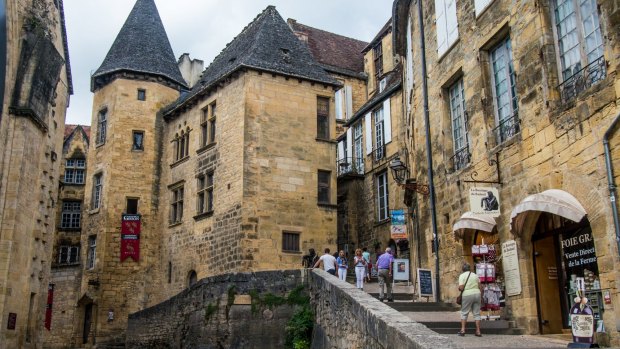
Centuries-old buildings lean together in the old towns of Sarlat.Credit: Diane Armstrong
The mushroom market is in full swing when we arrive, and under the arcades of the village square the locals are checking out enormous orange cepes which look as if they grew in the land of the Wizard of Oz.
The ancient square is surrounded by medieval buildings crookedly leaning towards each other, but there isn't a tourist in sight.
As I wander around the market, mingling with the country folk, a stout woman in a red parka whispers, 'They'll ask 15 euros for a box, but you can buy it for 10.' A few minutes later she was clutching a carton heaped with cepes. "Five euros!" she exulted.
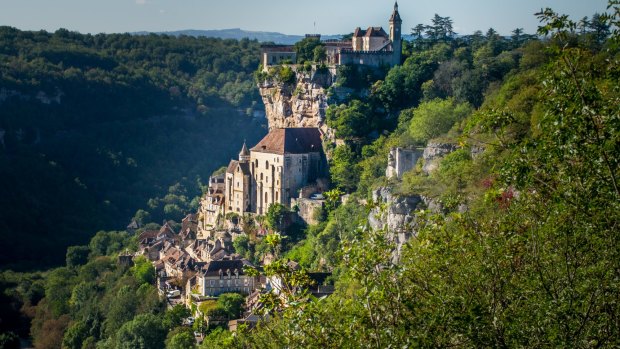
Sarlat, France.Credit: Diane Armstrong
Luck has brought us to Montpazier today: these spectacular mushrooms only grow under green oak and chestnut trees and can't be cultivated, so this market only takes place once a year.
But even apart from the mushroom market, it was worth coming to this ancient walled town which gives glimpses of timeless rural life in the Dordogne. The drive to Montpazier, through the idyllic landscape of south-west France, takes us along an enchanting countryside of dense oak and pine forests, shimmering cornfields, and hamlets with stone farmhouses. On the way back to Sarlat, we explore Villefranche, another historic township nearby.
Sarlat-la-Caneda, where we spend 12 days, is the ideal centre for exploring the Dordogne, a region that is over-endowed with attractions: magnificent countryside, superb food and wine, prehistoric caves, and ancient villages which hold colourful weekly markets.
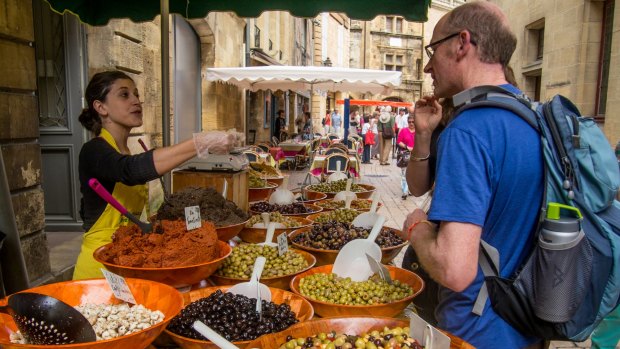
Local produce at Sarlat market.Credit: Diane Armstrong
Sarlat is a medieval township with historic buildings surrounding a cobbled square. Every turn of its twisting alleyways reveals scenes that make me feel as if I've stepped into a picturebook set in the Middle Ages, but according to our vivacious guide, Francoise, walking along these cobbled lanes wouldn't have been so delightful back then: the narrow spaces left in between the tall houses were used for emptying chamber pots.
Sarlat was founded by Benedictine monks in the 12th century, and became a pilgrimage centre. It still is, but today's pilgrims carry cameras instead of rosaries.
The Dordogne has been described as the land of a thousand castles, and as we drive around, it seems that around every bend, a stunning feudal chateau is perched on a vertiginous bluff of golden sandstone.
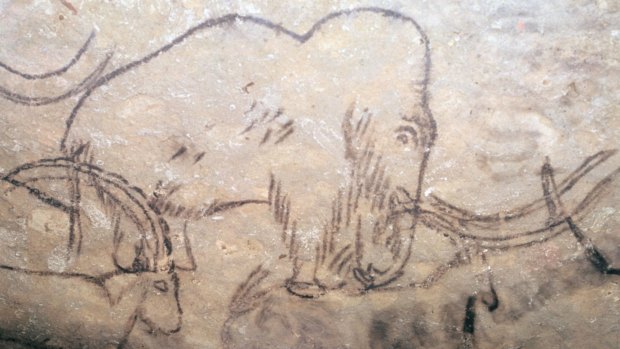
Neolithic cave-painting of mammoth and ibexes, from the ceiling of the Rouffignac Cave in Dordogne.Credit: Getty Images
In the pretty riverside village of La Roque Gageac, where the churches and houses seem to grow out of the perpendicular cliff wall, flat-bottomed boats called gabarres cruise along the river that winds through this lovely countryside. At the far end of the village, the gabarre passes a turreted chateau that might have been Snow White's castle.
But is nothing cute about the Chateau of Castelnaud which we visit later that day. This brooding feudal fortress poised high above the road makes me gasp and we spend several hours exploring it. A highlight is the artillery tower with its astonishing display of authentic medieval weapons. On the parapet stand two trebuchets, the huge rock-slinging machines often reproduced in movies set in medieval times.
The castle's entry fee of $21 includes a visit to the hanging gardens of Marqueyssac, where six kilometres of cool, peaceful alleys are lined with 150,000 box plants trimmed in fanciful shapes. Our long climb to the Belvedere at the summit rewards us with panoramic views over the Dordogne River and its fields of emerald and gold that seem to stretch forever.
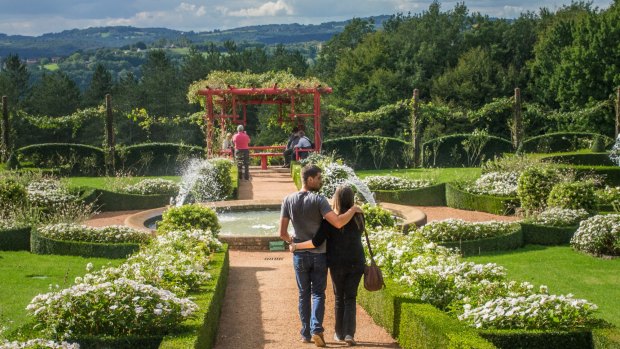
Picture perfect: Sarlat, France.Credit: Diane Armstrong
At the foot of the castle, we stop for lunch at the La Cour de Recre. Naturally we order cepe omelettes which are delicious, followed by creme brulee.
The Dordogne is renowned for its cuisine, especially for gourmet food the health-conscious regard as death on a plate, like duck confit, pate de foie gras, and potatoes baked with raclette cheese.
The stalls at the Wednesday and Saturday market in Sarlat are heaped with a mouth-watering array of cheeses, locally made sausage and nougat, while boutiques lining the square specialise in duck confit and pate de foie gras.
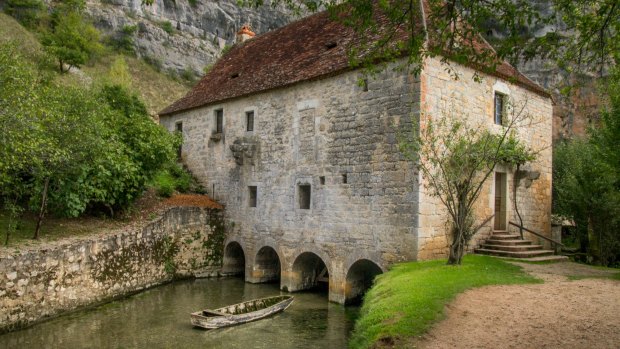
Sarlat, France.Credit: Diane Armstrong
In the village of Beynac, we lunch under the vine-covered pergola of La Petite Tonnelle – tasty fish soup, followed by roast veal with a cepe sauce, and then a tangy passionfruit souffle as light as gauze is accompanied by a cornet of filo pastry filled with fresh fruit.
We had come to Beynac to see the castle, and as we stroll along the steep main street in a vain effort to walk off the calories, I look up and see a castle floating in the sky.
This is the Chateau de Beynac, whose iron portcullis and weathered timber gate guard the massive ramparts Richard the Lionheart once occupied. The enormous baronial hall with its high vaulted ceiling, long rough-hewn table with swords stuck at each end and huge fireplace, is so evocative that I imagine the knights have just galloped away and will soon return.
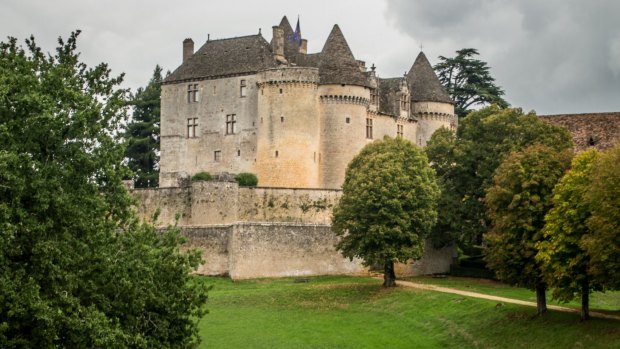
Magnificent chateaus dominate the area.Credit: Diane Armstrong
Exploring the feudal castles of the Dordogne take us back 900 years, but exploring its prehistoric caves take us back a staggering 15,000 years to the Cromagnon people. Rouffignac, one of the largest caves ever discovered, is privately owned: it appears that when you purchase a home in France, you also own what lies beneath the ground.
Our guide says he loves watching the faces of visitors when they enter these extraordinary caves, and I can understand why.
Nothing had prepared me for the thrill of seeing walls etched with the claw marks of thousands of cave bears back in the Ice Age. Or for the sight that stuns me when I alight from the small open train that takes us deep underground.
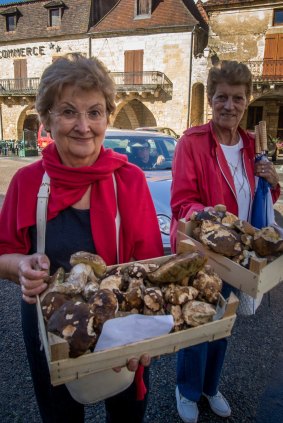
Happy customers at the mushroom market. Credit: Diane Armstrong
I am looking at a prehistoric Sistine Chapel, a huge cave ceiling covered with powerful drawings of bison, mammoths and woolly rhinos which apparently inspired Picasso. We don't know why these prehistoric artists drew the animals, or how they managed to paint the ceiling, but their accurate depiction is astonishing.
A steep path lined with oaks, fig trees, hazelnut trees and wild orchids leads to the Font de Gaume, the last polychrome cave still open to the public. Silence falls when we gaze at the long bison frieze, which follows the curve of the cliff, and at the painting of two reindeer facing each other, one licking the other's antlers.
The cave at Les Combarelles, which was used by a local farmer as a storage barn until he noticed the engraving of a horse on the wall, is an extraordinary collection of more than 1000 delicate animal engravings etched into the limestone of a narrow underground gallery. Some of them are difficult to make out until the stroppy French guide shines her torch on them.
Fifteen thousand years after our Cro-magnon ancestors left these paintings and carvings on the walls of these caves, they reveal that the desire to communicate is universal, that art is timeless. I left the caves feeling that I have seen the cradle of the human soul.
TRIP NOTES
MORE INFORMATION
GETTING THERE
Trains from Bergerac and Bordeaux stop at Sarlat. We rented a car in Bordeaux and drove to Sarlat, stopping overnight in the gorgeous wine region of Saint-Emilion.
STAYING THERE
L'Incontournable, a luxurious villa 2.7 kilometres from Sarlat, contains eight attractively decorated rooms, along with an indoor heated pool, tennis court, games room and movie theatre. From A$1357 for five nights, see villa-luxe-Sarlat.com.
TOURING THERE
Tickets for the caves are available from the office at Font de Gaume. Some caves have limited numbers, so arrive early. To get the most from your visit, engage an English-speaking guide for the day. Our guide, Alistair Croxton, croxton@club-internet.fr was very knowledgeable. The Tourist office in Sarlat in Rue Tourny organises history walks.
Diane Armstrong travelled at her own expense.
Sign up for the Traveller Deals newsletter
Get exclusive travel deals delivered straight to your inbox. Sign up now.